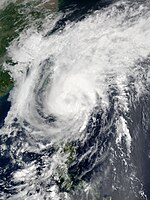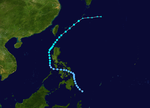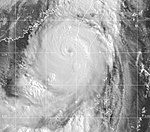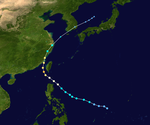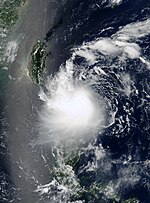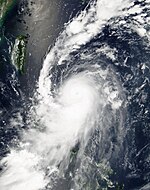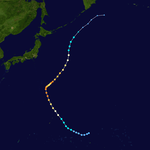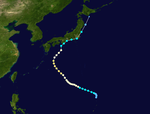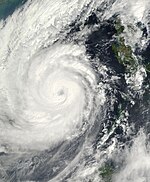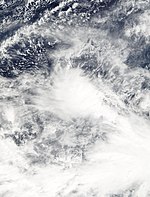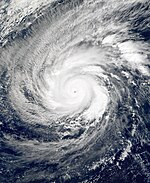2001 Pacific typhoon season
| 2001 Pacific typhoon season | |
|---|---|
 Season summary map | |
| Seasonal boundaries | |
| First system formed | February 17, 2001 |
| Last system dissipated | December 28, 2001[a] |
| Strongest storm | |
| Name | Faxai |
| • Maximum winds | 195 km/h (120 mph) (10-minute sustained) |
| • Lowest pressure | 915 hPa (mbar) |
| Seasonal statistics | |
| Total depressions | 44, 2 unofficial |
| Total storms | 25, 1 unofficial |
| Typhoons | 16[b] |
| Super typhoons | 3 (unofficial) |
| Total fatalities | 1,372 total |
| Total damage | $2.418 billion (2001 USD) |
| Related articles | |
The 2001 Pacific typhoon season was the fourth and final consecutive year with below-average activity, mainly due to the presence of a strong
The season was relatively inactive, with the first named storm, Cimaron, not developing until May 9. Taiwan suffered the most destruction from typhoons this year, with Typhoons Toraji, Nari, and Lekima being responsible for nearly 300 deaths in that island alone, making it one of the deadliest typhoon seasons in recorded history in that island. In November, Typhoon Lingling impacted the Philippines, killing 171 people, making it one of the deadliest Philippine storms this century. The season ended with the formation of Tropical Storm Vamei during the last week of December. Vamei would be notable for becoming the lowest latitude tropical storm, at 1.4°N, ever to be observed in the Northwest Pacific.
The scope of this article is limited to the Pacific Ocean, north of the equator and west of the
Seasonal forecasts
| TSR forecasts Date |
Tropical storms |
Total Typhoons |
Intense TCs |
Ref |
|---|---|---|---|---|
| Average (1971–2000) | 27.2 | 17.0 | 8.2 | [3] |
| January 31, 2001 | 28.1 | 16.2 | 6.6 | [3] |
| June 15, 2001 | 26.1 | 17.5 | 8.7 | [4] |
| 2001 season | Forecast Center |
Tropical cyclones |
Tropical storms |
Typhoons |
| Actual activity: | JMA | 43 | 25 | 16 |
| Actual activity: | JTWC | 33 | 30 | 20 |
| Actual activity: | PAGASA | 17 | 12 | 6 |
During the year, the
On January 31, Tropical Storm Risk (TSR) issued their extended range forecast for the Northwest Pacific in 2001, predicting near-average activity in terms of tropical storms, but a slightly below average in terms of typhoons. They predict that around 28 tropical storms would form, in which 17 of them would become typhoons, and 8 would further intensify to intense typhoons. TSR uses anomalous patterns of
Seasonal summary

This section needs expansion. You can help by adding to it. (February 2023) |
The Accumulated Cyclone Energy (ACE) index for the 2001 Pacific typhoon season as calculated by Colorado State University using data from the Joint Typhoon Warning Center was 307.3 units.[1] Broadly speaking, ACE is a measure of the power of a tropical or subtropical storm multiplied by the length of time it existed. It is only calculated for full advisories on specific tropical and subtropical systems reaching or exceeding wind speeds of 39 miles per hour (63 km/h).
The season ran with weak
2001 opened with Tropical Storm Soulik, from the previous season, active in the Philippine Sea. Soulik strengthened into the first typhoon seen this year and reached its peak intensity as a Category 3-equivalent typhoon on January 3, before quickly dissipating the next day.[7] The formation of Tropical Depression 01W (Auring), however, officially initiated the start of the annual typhoon season on February 17.[8] No tropical cyclones developed until after two months later, when another tropical depression had developed to the southeast of the Philippines.[9] Tropical cyclogenesis gradually increased when May arrived – with three tropical systems developing. Two of these systems were only recognised as minor tropical depressions, while the other strengthened to the first official named storm of this year, Cimaron, which moved through the Philippine archipelago in the middle of the month.[10]
Systems
Tropical Depression 01W (Auring)
| Tropical depression (JMA) | |
| Tropical depression (SSHWS) | |
| Duration | February 17 – February 20 |
|---|---|
| Peak intensity | 55 km/h (35 mph) (10-min); 1004 hPa (mbar) |
On 18:00 UTC of February 17, both the JMA and PAGASA began to track a tropical depression that was located about 324 km (201 mi) to the northeast of Surigao of Northern Mindanao. The PAGASA named the system, Auring.[8] The JTWC followed suit and designated it 01W, six hours later.[11] Auring moved westward and began traversing the Philippine archipelago of Visayas. By February 19, the PAGASA issued its final warning on Auring.[8] The JTWC also issued its final advisory on the system on February 20.[11] The JMA downgraded the system to a low-pressure area, and its remnants tracked northward, where it was last noted off the coast of the Ilocos Region on February 23.[12]
Auring brought rainfall throughout most of Visayas and Mindanao. At least 18 people died, with most of these deaths due to landslides that occurred from the torrential rain. In Leyte and most of Mindanao, flooding submerged the homes of 159,785 people. Damages from crops and property have been estimated at ₱200 million (US$4.16 million).[8]
Tropical Depression 02W (Barok)
| Tropical depression (JMA) | |
| Tropical depression (SSHWS) | |
| Duration | April 16 – April 18 |
|---|---|
| Peak intensity | 45 km/h (30 mph) (10-min); 1004 hPa (mbar) |
The PAGASA began issuing advisories on Tropical Depression Barok on 06:00 UTC of April 16, located to the wast of Palau.[9] Six hours later, the JTWC followed suit on initiating advisories, where they designated it as 02W. Barok moved in a northwestward direction well to the east of the Philippines without any intensification.[11] By April 19, both agencies stopped warning on the system when the depression quickly deteriorated. Even though warnings were discontinued, its remnants continued to show signs of life with several bursts of convection. This prompted the JTWC to issue a Tropical Cyclone Formation Alert (TCFA) on April 21, however its convection significantly weakened.[9]
Severe Tropical Storm Cimaron (Crising)
| Severe tropical storm (JMA) | |
| Tropical storm (SSHWS) | |
| Duration | May 9 – May 15 |
|---|---|
| Peak intensity | 95 km/h (60 mph) (10-min); 985 hPa (mbar) |
A weak low-level circulation center (LLCC) south of
After having become an extratropical cyclone, strong winds struck the
Typhoon Chebi (Emong)
| Typhoon (JMA) | |
| Category 3 typhoon (SSHWS) | |
| Duration | June 19 – June 24 |
|---|---|
| Peak intensity | 120 km/h (75 mph) (10-min); 965 hPa (mbar) |
On June 19, an area of convection developed southeast of
Chebi killed 82 people, mostly in China, and left $422 million (2001 USD), $457 million (2005 USD). Chebi's heavy rains and strong winds left nine people dead, 28 missing and $13 million (2001 USD) in damage in the Philippines. Four of the nine were from a Belizean
Severe Tropical Storm Durian
| Severe tropical storm (JMA) | |
| Category 1 typhoon (SSHWS) | |
| Duration | June 29 – July 2 |
|---|---|
| Peak intensity | 110 km/h (70 mph) (10-min); 970 hPa (mbar) |
The monsoon trough produced another disturbance that upgraded into a tropical depression to the west of Luzon on June 29. The tropical depression tracked northwestward while a subtropical ridge influenced the depression and caused it to upgrade to Tropical Storm Durian on June 30.[17] The storm attained severe tropical storm status at 18:00 UTC the same day,[13] with 10-minute winds of 110 km/h (70 mph) and 1-minute winds of 140 km/h (85 mph), making it equivalent to Category 1 winds on the Saffir–Simpson scale.[17] Durian had an atmospheric pressure of 970 hPa (29 inHg).[13] Durian made landfall on the Leizhou Peninsula,[13] before rapidly weakening as it continued in the same direction before the JTWC stopped advisories of the storm on July 2,[11] with the JMA doing the same the following day.[13]
The name Durian was submitted by
Severe Tropical Storm Utor (Feria)
| Severe tropical storm (JMA) | |
| Category 1 typhoon (SSHWS) | |
| Duration | July 1 – July 7 |
|---|---|
| Peak intensity | 110 km/h (70 mph) (10-min); 960 hPa (mbar) |
Utor spawned from an area of convection that developed off 907 km (565 mi) south-southeast of Guam on June 26, that remained quasi-stationary for 2 days before upgrading to a tropical depression on July 1 due to favorable conditions such as low vertical shear.[27] The depression strengthen into a tropical storm at 00:00 UTC on July 2.[13][27] Utor tracked west-northwest from a peripheral ridge and developed further, after entering the Philippine Area of Responsibility, and attained severe tropical storm status the following day. Utor was a large cyclone, with gale-force wind of 250 nmi (465 km; 290 mi).[11] Utor reached its peak strength on June 4, with 10-minute winds of 110 km/h (70 mph) and 1-minute winds of 150 km/h (95 mph), with the barometric pressure of 960 hPa (28 inHg).[13][11] Utor was centered 56 km (35 mi) near northern Luzon and tracked northwesterly as it began to weaken.[27] The storm made landfall near the east of Hong Kong on July 5 and quickly weakened before being last noted on July 7 by the JMA.[13]
Utor, while not a very strong storm, brought heavy rain amounting to $297.2 million (2001 USD) in damage, as well as causing 203 fatalities.[27]
Tropical Storm Trami (Gorio)
| Tropical storm (JMA) | |
| Tropical storm (SSHWS) | |
| Duration | July 8 – July 11 |
|---|---|
| Peak intensity | 75 km/h (45 mph) (10-min); 994 hPa (mbar) |
Tropical Storm Trami originated from a disturbance that developed about 222 km (138 mi) northwest of Chuuk on July 3.[11] Bursts of deep convection near the center were observed on the 7th, although the system remained disorganized.[27] Organization improved and by July 8, was upgraded to a tropical depression. Moving northwestward, the system gradually intensified, and the PAGASA began initiating advisories on 18:00 UTC of the same day, naming the system, Gorio. Six hours later, the JTWC already deemed the system as Tropical Depression 07W. Deep convection persisted to the west of its well-defined, but a partially exposed center. Thus, the system gained strength into a tropical storm, with the JMA naming it as Trami. Northeasterly shear prevented the storm to significantly intensify, and therefore Trami maintained tropical storm intensity for a day — only peaking with 10-minute sustained wind speeds of 75 km/h (45 mph).[27][13] By 12:00 UTC of July 11, Trami moved over Taiwan and into the Taiwan Strait, where Trami rapidly weakened and dissipated.[13]
Trami mostly affected Taiwan with just rainfall. However,
Tropical Depression 08W
| Tropical depression (SSHWS) | |
| Duration | July 10 – July 11 |
|---|---|
| Peak intensity | 45 km/h (30 mph) (1-min); 1002 hPa (mbar) |
The JTWC began tracking Tropical Depression 08W about 972 km (604 mi) southwest of
Typhoon Kong-rey
| Typhoon (JMA) | |
| Category 2 typhoon (SSHWS) | |
| Duration | July 21 – July 28 |
|---|---|
| Peak intensity | 130 km/h (80 mph) (10-min); 955 hPa (mbar) |
Tropical Depression 09W developed from an area of
Severe Tropical Storm Yutu (Huaning)
| Severe tropical storm (JMA) | |
| Category 2 typhoon (SSHWS) | |
| Duration | July 22 – July 26 |
|---|---|
| Peak intensity | 100 km/h (65 mph) (10-min); 975 hPa (mbar) |
A tropical depression had developed to the east of the northern tip of
Upon its landfall, Yutu brought gusty winds and rainfall throughout the
Typhoon Toraji (Isang)
| Typhoon (JMA) | |
| Category 3 typhoon (SSHWS) | |
| Duration | July 25 – August 1 |
|---|---|
| Peak intensity | 140 km/h (85 mph) (10-min); 960 hPa (mbar) |
A persistent but isolated deep convection near a broad LLCC was embedded to the monsoon trough approximately 356 mi (573 km) west of Guam on July 24. After organization and further development, the disturbance formed as Tropical Depression 11W and received the name Isang from PAGASA on July 25.[27] The depression was far east of the Philippines as it tracked northwestward then west-northwestward. 11W intensified to tropical storm strength on July 27 east of Luzon. Toraji attained further to severe tropical storm status at 12:00 UTC before become a typhoon at 18:00 UTC the same day.[13] Toraji moved north-northwesterly due to forming in a weakness in the subtropical ridge.[27] Typhoon Toraji reached its peak strength on July 28, with 10-minute winds of 140 km/h (85 mph) and 1-minute winds of 185 km/h (115 mph), with the barometric pressure of 960 hPa (28 inHg), after making landfall in eastern Taiwan.[13][11] Toraji weakened and was downgraded to a tropical depression while being near the coast of southeastern China on July 30, before making landfall that day. Toraji transitioned to an extratropical cyclone on August 1 before dissipating 2 days later.[13]
Torrential rainfall produced by the storm triggered flash flooding and landslides across Taiwan, killing 200 people and leaving NT$7.7 billion (US$245 million) in damage.[28][29] At least 30 people were killed in a village located in Nantou County which was completely buried by mud and rocks. In the wake of the storm, Taiwan's Premier, Chang Chun-hsiung criticized the excessive development of Taiwan and lack of heedance of possible negative effects for the significant loss of life from Toraji. He also initiated a reforestation project to avoid future disasters of a similar scale.[30]
Typhoon Man-yi
| Typhoon (JMA) | |
| Category 4 typhoon (SSHWS) | |
| Duration | August 1 – August 9 |
|---|---|
| Peak intensity | 150 km/h (90 mph) (10-min); 955 hPa (mbar) |
On July 31, the JTWC started to monitor on a tropical disturbance that had developed about 278 km (173 mi) to the north of Pohnpei. The system developed into a tropical depression the next day, with the JTWC designating it as 12W. A central dense overcast built up over cloud tops as cold as −83 °C (−117 °F) from infrared satellite imagery.[31] 12W further strengthened to a tropical storm by August 2, with the JMA receiving the name Man-yi.[13]
The system gradually intensified as it moved northwest, with the JTWC considering Man-yi a minimal typhoon on the next day.
Tropical Storm Usagi
| Tropical storm (JMA) | |
| Tropical storm (SSHWS) | |
| Duration | August 8 – August 11 |
|---|---|
| Peak intensity | 65 km/h (40 mph) (10-min); 992 hPa (mbar) |
A weak tropical depression had persisted in the South China Sea, just west off Luzon on August 8.[13] On the next day, operationally, the JTWC began on issuing advisories on the system as Tropical Depression 13W.[11] However post-analysis showed that the system had already intensified into a tropical depression several hours earlier. Despite with an exposed center, a weak banding feature began to develop around it. Organization of the 13W improved slightly, and by August 10, the system had intensified into a tropical storm, with the JMA naming it Usagi.[31][13] Usagi reached its maximum intensity only with 10-minute sustained wind speeds of 65 km/h (40 mph). By 18:00 UTC, Usagi moved inland Vietnam, just to the south of Hanoi, and therefore the JTWC issued its final advisory on the system. The storm continued moving westward over land until it was last noticed by the JMA on August 11.[31]
The storm brought heavy rainfall and flash flooding mostly in
Typhoon Pabuk
| Typhoon (JMA) | |
| Category 2 typhoon (SSHWS) | |
| Duration | August 13 – August 22 |
|---|---|
| Peak intensity | 130 km/h (80 mph) (10-min); 960 hPa (mbar) |
On August 13, the JMA started to track a tropical depression that was embedded to the
Pabuk brought heavy rainfall in the southern part of
Tropical Depression 15W
| Tropical depression (JMA) | |
| Tropical depression (SSHWS) | |
| Duration | August 24 – August 28 |
|---|---|
| Peak intensity | 55 km/h (35 mph) (10-min); 1000 hPa (mbar) |
On 12:00 UTC of August 24, the JMA started to track a weak tropical depression that had developed about 648 km (403 mi) to the northwest of
Typhoon Wutip
| Very strong typhoon (JMA) | |
| Category 4 super typhoon (SSHWS) | |
| Duration | August 26 – September 2 |
|---|---|
| Peak intensity | 165 km/h (105 mph) (10-min); 930 hPa (mbar) |
A tropical disturbance that was embedded in a broad monsoonal circulation developed in the Philippine Sea on August 25.[31] The JMA classified the system as a tropical depression on the next day.[13] Early on August 27, the JTWC followed suit and began initiating advisories on Tropical Depression 16W, after improved organisation and increased convection.[11] 16W quickly strengthened into a tropical storm thereafter, with the JMA naming it Wutip.[13]
By August 28, an eye feature began to develop, forcing both agencies to quickly upgrade Wutip to a typhoon.
Tropical Storm Sepat
| Tropical storm (JMA) | |
| Tropical storm (SSHWS) | |
| Duration | August 26 – August 30 |
|---|---|
| Peak intensity | 85 km/h (50 mph) (10-min); 990 hPa (mbar) |
Sepat originated from an extensive
Tropical Storm Fitow
| Tropical storm (JMA) | |
| Tropical storm (SSHWS) | |
| Duration | August 28 – September 1 |
|---|---|
| Peak intensity | 65 km/h (40 mph) (10-min); 990 hPa (mbar) |
Initially an area of thunderstorms formed west of Luzon late on August 26, possibly due to the remains of former Tropical Depression Jolina. Late on August 28 it formed into a tropical depression about 300 miles (480 km) south-southwest of Hong Kong. It moved west-northwest over northeastern Hainan late on August 29, before becoming a tropical storm 24 hours later. Early on August 31, the tropical storm began to drift north towards China. That evening, it struck Dongxing before weakening back into a tropical depression on September 1 and dissipating the following day.[31]
Excessive rains fell in mainland China, with locations in
Typhoon Danas
| Very strong typhoon (JMA) | |
| Category 3 typhoon (SSHWS) | |
| Duration | September 3 – September 12 |
|---|---|
| Peak intensity | 155 km/h (100 mph) (10-min); 945 hPa (mbar) |
An area of
On September 10, Danas spawned a tornado near the city of Ochiai, just outside Tokyo. Along its track, the tornado damaged roofs, downed trees and injured one person. Following an assessment of the damage, the Tokyo District Meteorological Observatory ranked it as an F1 on the Fujita scale. According to reliable records, this was the eleventh tornado to touch down in the Kantō region.[42] The town of Nikkō had recorded 870 mm (34 in) of rainfall over a four-day period. More than 140 domestic and international flights were canceled due to extreme winds and torrential rainfall.[41] Throughout Japan, Danas was responsible for eight fatalities and injured 48 people. Damages from the storm amounted to ¥11.1 billion (US$91 million).[43]
Typhoon Nari (Kiko)
| Typhoon (JMA) | |
| Category 3 typhoon (SSHWS) | |
| Duration | September 5 – September 21 |
|---|---|
| Peak intensity | 140 km/h (85 mph) (10-min); 960 hPa (mbar) |
On September 5, a tropical depression developed northeast of Taiwan. Weak currents, which were prevalent throughout its lifetime, caused it to drift to the northeast where it became a tropical storm on the 6th.
Nari caused 92 casualties[44] and up to 50 inches (1,300 mm) of rain led to torrential flooding.
Typhoon Vipa
| Typhoon (JMA) | |
| Category 1 typhoon (SSHWS) | |
| Duration | September 17 – September 21 |
|---|---|
| Peak intensity | 120 km/h (75 mph) (10-min); 975 hPa (mbar) |
Vipa originated from an
Typhoon Francisco
| Very strong typhoon (JMA) | |
| Category 3 typhoon (SSHWS) | |
| Duration | September 18 – September 25 |
|---|---|
| Peak intensity | 155 km/h (100 mph) (10-min); 945 hPa (mbar) |
On 00:00 UTC of September 18, the JMA began to monitor on a tropical depression that had developed about 509 km (316 mi) south-southeast of
Typhoon Lekima (Labuyo)
| Typhoon (JMA) | |
| Category 2 typhoon (SSHWS) | |
| Duration | September 22 – September 30 |
|---|---|
| Peak intensity | 130 km/h (80 mph) (10-min); 965 hPa (mbar) |
Late on September 19, an area of
The typhoon caused severe impacts in Taiwan as what
Typhoon Krosa
| Typhoon (JMA) | |
| Category 3 typhoon (SSHWS) | |
| Duration | October 3 – October 9 |
|---|---|
| Peak intensity | 150 km/h (90 mph) (10-min); 950 hPa (mbar) |
A rapidly developing area of
Typhoon Haiyan (Maring)
| Typhoon (JMA) | |
| Category 2 typhoon (SSHWS) | |
| Duration | October 11 – October 18 |
|---|---|
| Peak intensity | 130 km/h (80 mph) (10-min); 960 hPa (mbar) |
Tropical Depression 25W formed over the Philippine Sea on October 11.[11] The PAGASA named it as Maring 3 hours later. Maring steadily moved northwards due to an intensifying high-pressure area moving southwestwards, as the JTWC upgraded it to a tropical storm on October 13. In the same time, Maring became Tropical Storm Haiyan. The next day, the three agencies, upgraded it to a typhoon. Typhoon Haiyan reached peak intensity with winds equivalent to Category 2 strength on October 15. As the high-pressure moved westwards, Haiyan rapidly weakened to a minimal typhoon and moved westwards too, affecting Taiwan. Haiyan finally dissipated on October 18.[46]
Throughout Japan and the Ryukyu Islands, two people were killed by the typhoon and another was injured. Damage from the storm amounted to 296.024 million yen (US$3.4 million).[citation needed]
Typhoon Podul
| Very strong typhoon (JMA) | |
| Category 5 super typhoon (SSHWS) | |
| Duration | October 18 – October 27 |
|---|---|
| Peak intensity | 185 km/h (115 mph) (10-min); 925 hPa (mbar) |
Typhoon Podul originated from an area of convection located near Pohnpei on October 16. The system experienced vertical wind shear before strengthening to a tropical depression on October 18, before upgrading further to a tropical storm on October 20.[11] Due to the increase of deep convection and the organization of the system's center, Podul was upgraded to a typhoon by the JTWC on the 21st while being centered about 480 km (300 mi) north-northwest of Pohnpei or 1,296 km (805 mi) east of Guam.[46] The JMA however, upgraded the storm the following day to Typhoon Podul, as the storm shifted north-northeastward after making a half-counterclockwise turn.[13]
Podul underwent steady intensification while its well-defined eye had developed on October 23. As it continued its northwestward trek, satellite imagery showed that Podul underwent a concentric eyewall cycle on the 24th.[11] Podul reached its peak intensity on the 25th, with 10-minute winds of 185 km/h (115 mph) and 1-minute winds of 260 km/h (160 mph), prompting the JTWC to classify the storm as a super typhoon.[46] Its barometric pressure was 925 hPa (27.3 inHg) by that time.[13] Although it still had super typhoon strength, Podul showed its first signs of extratropical transition and by 18:00 UTC, was located 1,296 km (805 mi) northwest of Wake Island. Podul would retain the super typhoon strength for 72 hours, before its winds weakened to 220 km/h (135 mph).[46] Podul recurved and accelerated north-northeast as it began to rapidly weaken from dry air and cold air advection and transitioned to an extratropical cyclone on the 28th before dissipating the next day.[46]
Typhoon Lingling (Nanang)
| Very strong typhoon (JMA) | |
| Category 4 typhoon (SSHWS) | |
| Duration | November 6 – November 12 |
|---|---|
| Peak intensity | 155 km/h (100 mph) (10-min); 940 hPa (mbar) |
A tropical depression formed in the Philippine Sea on November 5. It moved westward, hitting the Philippines on the 6th.[11] The depression strengthened over the archipelago, becoming a tropical storm on the 7th. Lingling continued to intensify, reaching a peak of 130 mph (210 km/h) winds on the 10th in the South China Sea. The next day, the typhoon hit central Vietnam as a 110 mph (180 km/h) typhoon, and dissipated on the 12th.[13]
Lingling, like most typhoons, brought torrential rains and flooding, resulting in 171 deaths in the Philippines (with 118 missing) and 18 deaths in Vietnam.[47]
Tropical Depression 28W (Ondoy)
| Tropical depression (PAGASA) | |
| Tropical storm (SSHWS) | |
| Duration | November 17 – November 25 |
|---|---|
| Peak intensity | 55 km/h (35 mph) (10-min); 996 hPa (mbar) |
A tropical disturbance associated with the
Tropical Depression 29W (Pabling)
| Tropical depression (PAGASA) | |
| Tropical storm (SSHWS) | |
| Duration | November 18 – November 24 |
|---|---|
| Peak intensity | 55 km/h (35 mph) (10-min); 1004 hPa (mbar) |
On November 18, the JMA began to track a tropical depression that had developed about 426 km (265 mi) northeast of Singapore. By the next day, the system began to drift eastward, with satellite imagery depicting a convective banding feature with some deep convection.[47] The JTWC upgraded the system to a tropical depression and issued its first advisory on 06:00 UTC of November 20, receiving the designation 29W.[11] 29W intensified into a tropical storm by the JTWC on 00:00 UTC of November 21, when the system's vortex became well-defined. By the next day, the storm entered the western portion of the Philippine area of responsibility, with PAGASA giving the name Pabling.[47] On November 23, the JTWC downgraded Pabling back to a tropical depression after the system encountered increasing wind shear. The JTWC issued its final advisory shortly thereafter, when the storm was located just off the southern tip of Palawan. Pabling slowly dissipated the next day when it emerged in the waters of the Sulu Sea.[47]
Tropical Storm Kajiki (Quedan)
| Tropical storm (JMA) | |
| Tropical storm (SSHWS) | |
| Duration | December 4 – December 9 |
|---|---|
| Peak intensity | 65 km/h (40 mph) (10-min); 996 hPa (mbar) |
In the first few days of December, an area of convection developed to the south of Guam. By December 4, both the JMA and the PAGASA upgraded the system into a tropical depression, with the PAGASA naming it Quedan. After deep convection was seen developing from multi-spectral imagery,[48] the JTWC followed suit and began issuing advisories on 00:00 UTC of December 5 — giving the identifier of 30W.[11] On the same day, the system intensified into a tropical storm, with the JMA naming it as Kajiki.[13] Kajiki moved in a west-northwestward direction, traversing the islands of Visayas. By December 7, Kajiki emerged to the South China Sea, where unfavorable wind shear weakened the system. At this point, the storm's center started to become exposed and the storm's structure started to deteriorate. Both the JTWC and the JMA downgraded Kajiki to a tropical depression on the next day.[48] The JMA tracked Kajiki until it neared the eastern coast of Vietnam on December 9.[13]
In the
Tropical Storm 31W
| Tropical storm (SSHWS) | |
| Duration | December 10 – December 13 |
|---|---|
| Peak intensity | 65 km/h (40 mph) (1-min); 997 hPa (mbar) |
Operationally the same system as Typhoon Faxai, an area of unorganised convection in a region of weak to moderate vertical wind shear had persisted to the southwest of Pohnpei on December 10.[48] By 12:00 UTC of the same day, the JTWC upgraded the system to Tropical Depression 31W.[11] Satellite imagery and animations showed that there were multiple centers within the large-scale center, which made it difficult to track. By December 12, the system finally gained convection near its center.[48] 31W briefly reached tropical storm intensity by the JTWC on 18:00 UTC of the same day.[11] The storm was still difficult to track, which made one warning relocating the storm's center near the island of Kosrae.[48] However, after post-analysis, this center was a newly developed center that originated from the same surface trough of 31W. This new center eventually became Tropical Storm Faxai.[11]
Typhoon Faxai
| Violent typhoon (JMA) | |
| Category 5 super typhoon (SSHWS) | |
| Duration | December 13 – December 25 |
|---|---|
| Peak intensity | 195 km/h (120 mph) (10-min); 915 hPa (mbar) |
Typhoon Faxai originated from a low-latitude monsoon trough in the Caroline Islands that developed from the remnants of 31W through post-analysis on December 13.[48][11] The system would later become a tropical depression, giving it the initial designated name 31W by the JTWC. The tropical depression upgraded to a tropical storm by the JTWC on December 15, before the JMA follows suit on December 16, giving the storm the name Faxai. Tropical Storm Faxai remained stationed around Kosrae for several days before slowly moving in eastward motion. The storm then drifted west-northwestward and became more organized.[48] By December 21, the storm intensified into a typhoon and formed an eye.
The storm steadily went on a west-northwestward direction while positioned approximately 1,204 km (748 mi) southeast of the
Initially Faxai was classified as part of Tropical Depression 31W, but post-analysis considers the early part of Faxai's life a separate storm. As such, Faxai was classified as 33W in post-analysis.
Tropical Storm Vamei
| Tropical storm (JMA) | |
| Category 1 typhoon (SSHWS) | |
| Duration | December 26 – December 28 (Exited basin on Dec. 29) |
|---|---|
| Peak intensity | 85 km/h (50 mph) (10-min); 1006 hPa (mbar) |
Tropical Depression 32W formed 370 kilometres (230 miles) east of
Offshore of Malaysia, two
Other systems

On May 6, the JMA tracked a weak tropical depression off the northeastern coast of Mindanao. The system degenerated into a low-pressure area the next day.[55]
A tropical depression was briefly tracked by the Central Weather Bureau of Taiwan in the middle of May. On May 14, a tropical disturbance had developed off the coast of
On June 16, the PAGASA began initiating advisories on Tropical Depression Darna, that has developed just off the eastern coast of Luzon. As the system moved near the extreme northern portion of the archipelago, the system began in a north-northeastward trajectory towards Taiwan. On June 19, the JMA followed suit on classifying Darna to a tropical depression, however, being located in an area of weakly sheared environment, the system rapidly weakened and dissipated.[17][56]
On August 2, the JMA started to track a tropical depression that had developed about 972 km (604 mi) southeast of
On August 16, the PAGASA started to track Tropical Depression Jolina to the west of Dagupan. The depression slowly meandered in the place until its system's center became exposed, and dissipated on August 21.[31]
On October 20, a tropical depression had developed a couple hundred miles east of the coast of
Storm names
Within the North-western Pacific Ocean, both the
International names
During the season 26 named tropical cyclones developed in the Western Pacific and were named by the Japan Meteorological Agency, when it was determined that they had become tropical storms. These names were contributed to a list of a 140 names submitted by the fourteen members nations and territories of the
| Cimaron | Chebi | Durian | Utor | Trami | Kong-rey | Yutu | Toraji | Man-yi | Usagi | Pabuk | Wutip | Sepat |
| Fitow | Danas | Nari | Vipa | Francisco | Lekima | Krosa | Haiyan | Podul | Lingling | Kajiki | Faxai | Vamei |
This is the only time that the names "Vipa" and "Vamei" were used. The former's spelling was corrected to "Wipha" in 2002,[61] while the latter was retired.[62]
Philippines
| Auring | Barok | Crising | Darna | Emong |
| Feria | Gorio | Huaning | Isang | Jolina |
| Kiko | Labuyo | Maring | Nanang | Ondoy |
| Pabling | Quedan | Roleta (unused) | Sibak (unused) | Talahib (unused) |
| Ubbeng (unused) | Vinta (unused) | Wilma (unused) | Yaning (unused) | Zuma (unused) |
| Auxiliary list | ||||
|---|---|---|---|---|
| Alamid (unused) | Bruno (unused) | Conching (unused) | Dolor (unused) | Ekis (unused) |
| Fuerza (unused) | Gimbal (unused) | Hampas (unused) | Isko (unused) | Juego (unused) |
The
Retirement
The name Vamei was retired by the ESCAP/WMO Typhoon Committee. The name Peipah was chosen to replace Vamei. The name "Nanang" was retired by PAGASA and was replaced by Nando for 2005.
Season effects
This table lists all the storms that developed in the western Pacific Ocean to the west of the International Date Line during the 2001 season. It includes their intensity, duration, name, landfalls, deaths, and damages. All damage figures are in 2001 USD. Damages and deaths from a storm include when the storm was a precursor wave or extratropical low.
| Name | Dates | Peak intensity | Areas affected | Damage (USD) |
Deaths | Refs | ||
|---|---|---|---|---|---|---|---|---|
| Category | Wind speed | Pressure | ||||||
| 01W (Auring) | February 17 – 20 | Tropical depression | 55 km/h (34 mph) | 1,004 hPa (29.65 inHg) | Philippines | $4.16 million | 18 | |
| 02W (Barok) | April 16 – 18 | Tropical depression | 45 km/h (28 mph) | 1,004 hPa (29.65 inHg) | None | None | None | |
| TD | May 6 – 7 | Tropical depression | Not specified | 1,004 hPa (29.65 inHg) | Philippines | None | None | |
| TD | May 16 | Tropical depression | Not specified | Not specified | Vietnam | None | None | |
| Cimaron (Crising) | May 9 – 14 | Severe tropical storm | 95 km/h (59 mph) | 985 hPa (29.09 inHg) | Philippines, Taiwan | $555,000 | None | |
| Darna | June 17 – 19 | Tropical depression | 55 km/h (34 mph) | 1000 hPa (29.53 inHg) | Philippines | Unknown | None | |
| Chebi (Emong) | June 19 – 24 | Strong typhoon | 120 km/h (75 mph) | 965 hPa (28.50 inHg) | Philippines, China, Taiwan | $471 million | 108 | |
| Durian | June 29 – July 2 | Severe tropical storm | 95 km/h (59 mph) | 970 hPa (28.64 inHg) | China, Vietnam | $422 million | 110 | |
| Utor (Feria) | July 1 – 7 | Severe tropical storm | 110 km/h (68 mph) | 960 hPa (28.35 inHg) | Philippines, China, Taiwan | $332 million | 197 | |
| Trami (Gorio) | July 8 – 11 | Tropical storm | 75 km/h (47 mph) | 994 hPa (29.35 inHg) | Philippines, Taiwan, East China | Unknown | 5 | |
| 08W | July 10 – 11 | Tropical depression | 45 km/h (28 mph) | 1,002 hPa (29.59 inHg) | None | None | None | |
| TD | July 16 – 19 | Tropical depression | Not specified | 1,004 hPa (29.65 inHg) | None | Unknown | None | |
| Kong-rey | July 21 – 28 | Strong typhoon | 130 km/h (81 mph) | 955 hPa (28.2 inHg) | None | None | None | |
| Yutu (Huaning) | July 22 – 26 | Severe tropical storm | 100 km/h (62 mph) | 975 hPa (28.79 inHg) | Philippines, Vietnam, South China | $109 million | None | [27] |
| Toraji (Isang) | July 25 – August 1 | Strong typhoon | 140 km/h (87 mph) | 960 hPa (28.35 inHg) | Philippines, Taiwan, East China | $245 million | 200 | |
| Man-yi | August 1 – 9 | Strong typhoon | 150 km/h (93 mph) | 955 hPa (28.2 inHg) | Mariana Islands | $50,000 | None | |
| TD | August 2 – 3 | Tropical depression | Not specified | 1,004 hPa (29.65 inHg) | Taiwan, Ryukyu Islands | None | None | |
| TD | August 5 – 8 | Tropical depression | Not specified | 1,000 hPa (29.53 inHg) | Korean Peninsula |
None | None | |
| Usagi | August 8 – 11 | Tropical storm | 65 km/h (40 mph) | 992 hPa (29.29 inHg) | South China, Vietnam, Laos | $3.2 million | 176 | [33] |
| Pabuk | August 13 – 22 | Strong typhoon | 130 km/h (81 mph) | 960 hPa (28.35 inHg) | Mariana Islands, Japan | $5.55 million | 8 | [31][39] |
| Jolina | August 16 – 19 | Tropical depression | 55 km/h (34 mph) | 998 hPa (29.47 inHg) | Philippines | None | None | |
| TD | August 22 – 24 | Tropical depression | Not specified | 1,000 hPa (29.53 inHg) | None | None | None | |
| TD | August 22 – 23 | Tropical depression | Not specified | 1,002 hPa (29.59 inHg) | None | None | None | |
| 15W | August 24 – 28 | Tropical depression | 55 km/h (34 mph) | 1,000 hPa (29.53 inHg) | None | None | None | |
| Wutip | August 26 – September 2 | Very strong typhoon | 165 km/h (103 mph) | 930 hPa (27.46 inHg) | None | None | None | |
| Sepat | August 26 – 30 | Tropical storm | 85 km/h (53 mph) | 990 hPa (29.23 inHg) | None | None | None | |
| Fitow | August 28 – September 1 | Tropical storm | 85 km/h (53 mph) | 990 hPa (29.23 inHg) | South China | $202 million | 4 | |
| Danas | September 3 – 12 | Very strong typhoon | 155 km/h (96 mph) | 945 hPa (27.91 inHg) | Japan | $9.79 million | 8 | [43] |
| Nari (Kiko) | September 5 – 21 | Strong typhoon | 140 km/h (87 mph) | 960 hPa (28.35 inHg) | Japan, Taiwan, East China | $443 million | 104 | |
| TD | September 5 – 7 | Tropical depression | Not specified | 1,002 hPa (29.59 inHg) | South China | None | None | |
| TD | September 8 – 10 | Tropical depression | Not specified | 1,000 hPa (29.53 inHg) | Taiwan, Ryukyu Islands | None | None | |
| TD | September 9 – 12 | Tropical depression | Not specified | 1,000 hPa (29.53 inHg) | South China, Vietnam | None | None | |
| Vipa | September 17 – 21 | Strong typhoon | 120 km/h (75 mph) | 975 hPa (28.79 inHg) | Japan | None | None | |
| Francisco | September 18 – 25 | Very strong typhoon | 155 km/h (96 mph) | 945 hPa (27.91 inHg) | None | None | None | |
| Lekima (Labuyo) | September 22 – 30 | Strong typhoon | 130 km/h (81 mph) | 965 hPa (28.5 inHg) | Philippines, Taiwan, East China | Unknown | 5 | [41] |
| Krosa | October 3 – 9 | Strong typhoon | 150 km/h (93 mph) | 950 hPa (28.05 inHg) | Mariana Islands | None | None | |
| Haiyan (Maring) | October 11 – 18 | Strong typhoon | 130 km/h (81 mph) | 960 hPa (28.35 inHg) | Taiwan, Japan | $3.4 million | 2 | |
| Podul | October 19 – 27 | Very strong typhoon | 185 km/h (115 mph) | 925 hPa (27.32 inHg) | Caroline Islands | None | None | |
| TD | October 20 – 21 | Tropical depression | Not specified | 1,002 hPa (29.59 inHg) | Vietnam | $66.6 million | 39 | |
| Lingling (Nanang) | November 6 – 12 | Very strong typhoon | 155 km/h (96 mph) | 940 hPa (27.76 inHg) | Philippines, Vietnam, Cambodia | $70.3 million | 379 | |
| 28W (Ondoy) | November 17 – 25 | Tropical depression | 55 km/h (34 mph) | 996 hPa (29.41 inHg) | Caroline Islands, Mariana Islands, Philippines | None | None | |
| 29W (Pabling) | November 18 – 23 | Tropical depression | 55 km/h (34 mph) | 1,004 hPa (29.65 inHg) | Philippines, Malaysia, Brunei, Borneo | None | None | |
| Kajiki (Quedan) | December 4 – 9 | Tropical storm | 65 km/h (40 mph) | 996 hPa (29.41 inHg) | Philippines, Vietnam | $14 million | 2 | |
| 31W | December 10 – 12 | Tropical storm | 65 km/h (40 mph) | 997 hPa (29.44 inHg) | Caroline Islands | None | None | |
| Faxai | December 13 – 25 | Violent typhoon | 195 km/h (121 mph) | 915 hPa (27.02 inHg) | Caroline Islands, Mariana Islands | $1 million | 1 | |
| Vamei | December 26 – 28 | Tropical storm | 85 km/h (53 mph) | 1,006 hPa (29.71 inHg) | Singapore, Malaysia, Sumatra | $3.6 million | 5 | |
| Season aggregates | ||||||||
| 46 systems | February 17 – December 28, 2001 | 195 km/h (121 mph) | 915 hPa (27.02 inHg) | $2.42 billion | 1,372 | |||
See also
- List of Pacific typhoon seasons
- 2001 Pacific hurricane season
- 2001 Atlantic hurricane season
- 2001 North Indian Ocean cyclone season
- South-West Indian Ocean cyclone seasons: 2000–01, 2001–02
- Australian region cyclone seasons: 2000–01, 2001–02
- South Pacific cyclone seasons: 2000–01, 2001–02
Notes
- ^ The JMA, which is the RSMC of the Northwest Pacific, downgraded Vamei to remnant low on December 28, while the JTWC continued to track it as a tropical depression until it crossed the basin on December 29.
- ^ Typhoon Soulik is not included in this season's totals but from last season's totals, despite reaching this intensity this year.
References
- ^ a b "Basin Archives: Northwest Pacific Ocean Historical Tropical Cyclone Statistics". Fort Collins, Colorado: Colorado State University. Retrieved 25 May 2023.
- ^ "Archived copy". Archived from the original on 2010-11-30. Retrieved 2006-08-26.
{{cite web}}: CS1 maint: archived copy as title (link) - ^ a b c Paul Rockett; Mark Saunders (January 31, 2001). "Extended Range Forecast for NW Pacific and Japan Landfalling Tropical Storms in 2001" (PDF). TropicalStormRisk.com. Retrieved February 5, 2001.
- ^ a b Paul Rockett; Mark Saunders (June 15, 2001). "Pre-Season Forecast for NW Pacific and Japan Landfalling Typhoons in 2001" (PDF). TropicalStormRisk.com. Retrieved June 15, 2001.
- ^ "Historical El Niño/La Niña episodes (1950–present)". United States Climate Prediction Center. 1 February 2019. Retrieved 15 March 2019.
- ^ "Summary of 2001 NW Pacific Typhoon Season and Verification of Authors' Seasonal Forecasts" (PDF). Tropical Storm Risk. January 25, 2002.
- ^ Padgett, Gary (December 2000). "Monthly Global Tropical Cyclone Summary December 2000". Summaries and Track Data. Australiansevereweather.com.
- ^ a b c d Padgett, Gary (February 2001). "Monthly Global Tropical Cyclone Summary February 2001". Summaries and Track Data. Australiansevereweather.com.
- ^ a b c Padgett, Gary (April 2001). "Monthly Global Tropical Cyclone Summary April 2001". Summaries and Track Data. Australiansevereweather.com.
- ^ a b c d e Padgett, Gary (May 2001). "Monthly Global Tropical Cyclone Summary May 2001". Summaries and Track Data. Australiansevereweather.com.
- ^ a b c d e f g h i j k l m n o p q r s t u v w x y z aa ab ac ad ae af ag ah ai aj ak al am an ao ap aq ar as at au av aw ax ay az ba bb Joint Typhoon Warning Center. Annual Tropical Cyclone Report (PDF) (Report). United States Navy. Retrieved May 3, 2023.
- ^ "Digital Typhoon: List of weather charts on February 23, 2001 (Fri)". Digital Typhoon. February 23, 2001.
- ^ a b c d e f g h i j k l m n o p q r s t u v w x y z aa ab ac ad ae af ag ah ai aj ak al am an ao ap aq ar as at au av aw ax ay az ba bb bc bd be bf Annual Report on Activities of the RSMC Tokyo – Typhoon Center 2001 (PDF) (Report). Tokyo, Japan: Japan Meteorological Agency. Retrieved May 3, 2023.
- ^ KITAMOTO Asanobu. "Digital Typhoon: Weather Disaster Report (2001-918-01)". Digital Typhoon Disaster Database. National Institute of Informatics.
- ^ KITAMOTO Asanobu. "Digital Typhoon: Weather Disaster Report (2001-927-01)". Digital Typhoon Disaster Database. National Institute of Informatics.
- ^ KITAMOTO Asanobu. "Digital Typhoon: Weather Disaster Report (2001-936-03)". Digital Typhoon Disaster Database. National Institute of Informatics.
- ^ a b c d e f g h i Padgett, Gary (June 2001). "Monthly Global Tropical Cyclone Summary June 2001". Summaries and Track Data. Australiansevereweather.com.
- ^ http://72.14.207.104/search?q=cache:B1Z3B7KbI6kJ:www.japantoday.com/gidx/news37918.html+Typhoon+Chebi+,+Taiwan&hl=en&gl=us&ct=clnk&cd=4[permanent dead link]
- ^ "Five Killed, 28 Missing in Taiwan". www.china.org.cn. Retrieved 2023-02-01.
- ^ "Typhoon Chebi Brings Rainstorm for Guangdong". en.people.cn. Retrieved 2023-02-01.
- ^ http://72.14.207.104/search?q=cache:9R6lRuW8kScJ:www.japantoday.com/gidx/news37987.html+Typhoon+Chebi+,+Taiwan&hl=en&gl=us&ct=clnk&cd=3[permanent dead link]
- ^ "Typhoon Chebi Savages Fujian, At Least 79 Killed". en.people.cn. Retrieved 2023-02-01.
- ^ "Pravda.RU China: Typhoon Chebi's toll rises: 22 die in Hangzhou landslide". english.pravda.ru. Archived from the original on 13 September 2001. Retrieved 11 January 2022.
- ^ "Meaning of Tropical Cyclone Names". www.hko.gov.hk. Retrieved January 30, 2023.
- ^ a b "HKO Tropical Cyclones in 2001" (PDF). 2019-11-04. Archived from the original (PDF) on 2019-11-04. Retrieved 2021-03-06.
- ^ "Typhoon Utor claims 40 lives". 2001-07-05. Retrieved 2021-03-07.
- ^ a b c d e f g h i j k l m n o p q r s Padgett, Gary (July 2001). "Monthly Global Tropical Cyclone Summary July 2001". Summaries and Track Data. Australiansevereweather.com.
- ^ Staff Writer (August 4, 2005). "Typhoon strengthens near Taiwan". CNN. Retrieved April 22, 2010.
- ^ C.-Y. Chen, W.-C. Lee & F.-C. Yu (May 16, 2006). "Debris flow hazards and emergency response in Taiwan". Archived from the original on March 22, 2012. Retrieved April 22, 2010.
- ^ Staff Writer (August 3, 2001). "Chang slams over-farming". The China Post. Retrieved April 22, 2010.
- ^ a b c d e f g h i j k l m n o p q r s Padgett, Gary (August 2001). "Monthly Global Tropical Cyclone Summary August 2001". Summaries and Track Data. Australiansevereweather.com.
- ^ "Vietnam: Floods - Information Bulletin n° 1 - Viet Nam". September 21, 2001.
- ^ a b Carol Divjak, James Conachy (September 4, 2001). "Flood tragedy in Thailand linked to deforestation". World Socialist Web Site.
- ^ "Pre-Landfall 1". ALERT. Retrieved 2023-01-21.
- ^ Thompson, Alastair (August 20, 2001). "Weather: Destination Tokyo For Typhoon Pabuk". www.scoop.co.nz. Retrieved 2023-01-21.
- ^ "Landfall". ALERT. Retrieved 2023-01-21.
- ^ "Typhoon Pabuk targets west Japan". The Japan Times. August 20, 2001.
- ^ "Typhoon Pabuk Heading for Japan". Los Angeles Times. August 21, 2001.
- ^ a b "Typhoon 200111 (PABUK) - Disaster Information". Digital Typhoon.
- ^ "Digital Typhoon: List of weather charts on August 28, 2001 (Tue)". Digital Typhoon. August 28, 2001.
- ^ a b c d e f g h i j k l m n o p q r s t Padgett, Gary (September 2001). "Monthly Global Tropical Cyclone Summary September 2001". Summaries and Track Data. Australiansevereweather.com.
- ^ "Tokyo District Damage Report: Tornado" (in Japanese). National Institute of Informatics. 2001. Retrieved July 16, 2010.
- ^ a b "Typhoon 200115 (DANAS) - Disaster Information". Digital Typhoon.
- ^ Precipitation Processes Associated With the Landfalling Typhoon Nari (2001). Retrieved on 2007-02-25.
- ^ "PAGASA Tracker 12. Typhoon LABUYO (Lekima/23W)". Typhoon2000.
- ^ a b c d e f g h Padgett, Gary (October 2001). "Monthly Global Tropical Cyclone Summary October 2001". Summaries and Track Data. Australiansevereweather.com.
- ^ a b c d e f g Padgett, Gary (November 2001). "Monthly Global Tropical Cyclone Summary November 2001". Summaries and Track Data. Australiansevereweather.com.
- ^ a b c d e f g h i j k l m n Padgett, Gary (December 2001). "Monthly Global Tropical Cyclone Summary December 2001". Summaries and Track Data. Australiansevereweather.com.
- ^ Weather Bureau. October 2001. p. 83.
- ^ C.P. Chang; Ching-Hwang Liu; Hung-Chi Kuo (2003). "Typhoon Vamei: An Equatorial Tropical Cyclone Formation". Naval Postgraduate School Department of Meteorology. Archived from the original on 23 July 2012. Retrieved 14 April 2010.
- ^ Malaysian Meteorological Department. "Tropical Storm Vamei causes widespread floods in Johor". Archived from the original on 25 May 2008. Retrieved 14 April 2010.
- ^ Mahathir Told (8 January 2002). "Recent Floods Claimed Five Lives and Caused Substantial Damage" (PDF). Bernama: The Malaysian National News Agency. Archived from the original (PDF) on 21 December 2014. Retrieved 7 March 2008.
- ^ T.Y. Koh & H. Lim (2005). "Verification of a Mesoscale Simulation of Tropical Cyclone Vamei" (PDF). European Geosciences Union. Retrieved 14 April 2010.
- ^ Jack Williams (1 November 2004). "Why don't certain areas in Asia, like Singapore, have typhoons, tornadoes or other disastrous weather?". USAToday.com. Retrieved 14 April 2010.
- ^ "Digital Typhoon: List of weather charts on May 7, 2001 (Mon)". Digital Typhoon. May 7, 2001.
- ^ "Digital Typhoon: List of weather charts on June 19, 2001 (Tue)". Digital Typhoon. June 19, 2001.
- ^ "Digital Typhoon: List of weather charts on August 03, 2001 (Fri)". Digital Typhoon. August 3, 2001.
- ^ "Digital Typhoon: List of weather charts on August 05, 2001 (Sun)". Digital Typhoon. August 5, 2001.
- ^ a b Padgett, Gary. "Monthly Tropical Cyclone summary December 1999". Australian Severe Weather. Archived from the original on February 11, 2012. Retrieved August 28, 2012.
- ^ a b the Typhoon Committee (February 21, 2012). "Typhoon Committee Operational Manual 2012" (PDF). World Meteorological Organization. pp. 37–38. Archived (PDF) from the original on August 1, 2013.
- ^ "Typhoon Committee Operational Manual Meteorological Component" (PDF). World Meteorological Organization. p. 36. Archived (PDF) from the original on 26 September 2007. Retrieved 2007-09-16.
- ^ Tropical Cyclone Programme (2008). "Typhoon Committee Operational Manual — Meteorological Component" (PDF). World Meteorological Organization. Archived from the original (PDF) on 17 July 2012. Retrieved 14 April 2010.
External links
- Satellite movie of 2001 Pacific typhoon season
- Japan Meteorological Agency
- China Meteorological Agency
- National Weather Service Guam
- Hong Kong Observatory
- Macau Meteorological Geophysical Services
- Korea Meteorological Agency
- Philippine Atmospheric, Geophysical and Astronomical Services Administration
- Taiwan Central Weather Bureau
- Joint Typhoon Warning Center Archived 2010-03-01 at the Wayback Machine





